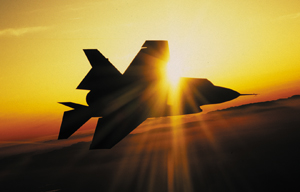At a recent Pentagon briefing, Defense Secretary Robert M. Gates remarked, “This notion that I’m tilting the scale dramatically against conventional capabilities … is just not accurate. You know, $1 trillion for the Joint Strike Fighter … is not a trivial investment in the future.”
Indeed, $1 trillion is no trivial amount. How does one arrive at that figure
 |
The F-35’s cost depends on what you count, and how you count it. |
This round number, while great for shock value, is debatable. It far surpasses all previous cost estimates. When the Pentagon last projected an official cost of the tri-service F-35 program, it was just shy of $300 billion.
Where does the higher number come from?
Pentagon press officials, when asked directly to provide the source for Gates’ claim, were unable to do so. All signs are that the Secretary was referring to claims by the Government Accountability Office.
As might be expected, what the F-35 costs depends on what you count and when and how you measure it. To accumulate a bill of $1 trillion for the F-35, one must toss the widest possible cost net and use inflated dollars.
There are many ways to estimate the cost of a program. The differing methods can be compared to a set of Russian matryoshka dolls; every time you open one, you find a smaller one inside. Starting with smallest matryoshka:
- Recurring Flyaway Cost. This is an aircraft’s “sticker price,” representing the cost to buy what you actually fly away. It excludes sunk costs such as R&D and testing.
- Flyaway Cost. A bit larger than recurring flyaway cost, this category averages in some nonrecurring expenses such as line startup costs.
- Weapon System Cost. The next level, weapon system cost, pulls in publications, technical data, support and training equipment, contractor services, and the like.
- Procurement Cost. This adds in initial spare parts and deployable spares packages. It captures expenses directly related to buying and initially operating the aircraft.
- Program Acquisition Cost. This includes military construction for new facilities; engineering and manufacturing development; and RDT&E costs.
- Life cycle cost. This one adds in the cost, over the entire life of the program, of operations and maintenance, support, and military personnel expenses. It includes even fuel and other consumables.
As if six cost categories were not confusing enough, one also must contend with three ways of computing costs.
The price can be deflated but held steady for comparative purposes by using a baseline year. For example, F-35 costs are sometimes presented in Fiscal 2002 dollars.
Current-year dollars are larger, and are achieved by converting costs over a lengthy program to a financial language everyone can understand—today’s dollars.
Then-year dollars include inflation and therefore yield the largest prices. The difference is huge in a program like the F-35, which will still be going in 2034, because an aircraft that costs $100 million today might cost $200 million 20 years from now simply because of inflation. However, Americans will still judge the cost by today’s standards, which inherently distorts the assessment.
Critics of big weapon programs, wishing to accentuate purported waste and expense, invariably cite the highest possible cost of targeted programs. Getting to $1 trillion requires the estimator to include all possible cost groups. Then, all future expenses must be expressed in inflated then-year dollars over a very long period. For example, F-35 expenses don’t stop with the end of production in 2034. They go on to include the cost of operating, maintaining, and upgrading the aircraft for as long as they last—another 20 to 30 years.
Think of cost estimates in terms of the family automobile.
If recurring flyaway cost represents a car’s sticker price, life cycle cost includes everything related to owning and operating the vehicle.
Count your share of development and testing costs that occurred before you bought the car. Include a lifetime of spare parts and “consumables” such as tires and wiper blades. Repairs, oil changes, and routine maintenance all count. If a new garage or driveway repairs are somehow related to the vehicle, tally them, too. Gas? Included. Future upgrades such as a new stereo, paint job, or portable GPS? Yes. Downtown parking? Of course.
This, as is readily seen, leads to a strikingly huge number. However, life cycle cost bears little resemblance to what most people consider the real cost of a vehicle.
We may now examine, with something like perspective, the GAO’s trillion dollar claim. In a March report, it alleged that the total F-35 investment “now exceeds $1 trillion,” which it broke out as more than “$300 billion to acquire 2,456 aircraft and $760 billion in life cycle operating and support costs.”
That’s right: Nearly three-quarters of the $1 trillion is the cost of ownership. These expenses are rightly considered O&M, but some would shove it all into the F-35 price tag.
So, what does the F-35 program really cost? The Pentagon pegs it at $298.8 billion in program acquisition cost, in then-year dollars. The Center for Strategic and Budgetary Assessments says this is roughly $251 billion in the dollars we spend today.
That’s not cheap, but a trillion dollars is off by a factor of four.
More information: http://www.gao.gov/new.items/d09303.pdf